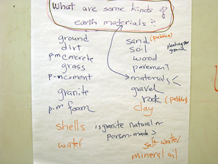What are some different kinds of earth materials?
2. Elicit ideas
Purpose of the discussion:
The purpose of this discussion is for students to become familiar with their own ideas about earth materials and to broaden their ideas by actively listening to others. The focus question for the discussion is: What earth materials are under your feet?
Engage students in the focus question
Ask students to think about places where Earth's surface is not hidden by sidewalks, streets, buildings, or other human–made objects. Provide examples: a beach, or a park. These are places where Earth's natural surface is visible.
Ask students to provide other examples (e.g., a garden, a ball field, a dirt road, a back yard, a field at a summer camp, a mountain trail, an ocean).
Invite students to pick one of those places, close their eyes, and imagine they are standing there barefoot.
Provide time for students to collect their thoughts.
Where are you? What earth materials are under your feet?

Record student responses (e.g., dirt, rocks, dead leaves, twigs, mud, sand, puddles).
Accept all suggestions without hesitation or passing judgment. A key purpose of this discussion is to engage students personally in the new investigation by welcoming their contributions. Students will have an opportunity to revisit the list later in the class, once they have explored some earth materials and have had more time to reflect on this new topic.
Note: Scientists do not include manufactured objects or living animals or plants as earth materials. They do consider dead or decomposed animals or plants as earth materials, along with rocks, sand, gravel, water, and other natural, non-manufactured materials. Do not share the scientists' definition of earth materials with students at this time. That can happen once they revisit the list they have generated, closer to the end of the session.
Demonstrate active listening and engagement by helping students build on and connect ideas, ask questions or make observations.
Summarize the discussion
Remind students that they started thinking about earth materials by imagining what might be under their feet in different places on Earth's surface, and came up with a class list. They will have time to suggest or debate changes to the list later. Explain that we might discover something else about the kinds of earth materials by closely observing some. So, the question we'll investigate today is:
What are some different kinds of earth materials?





